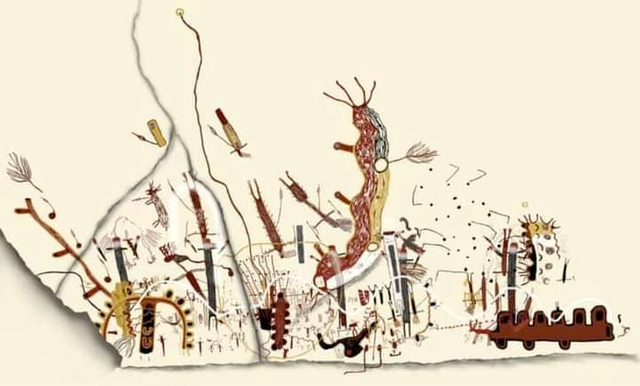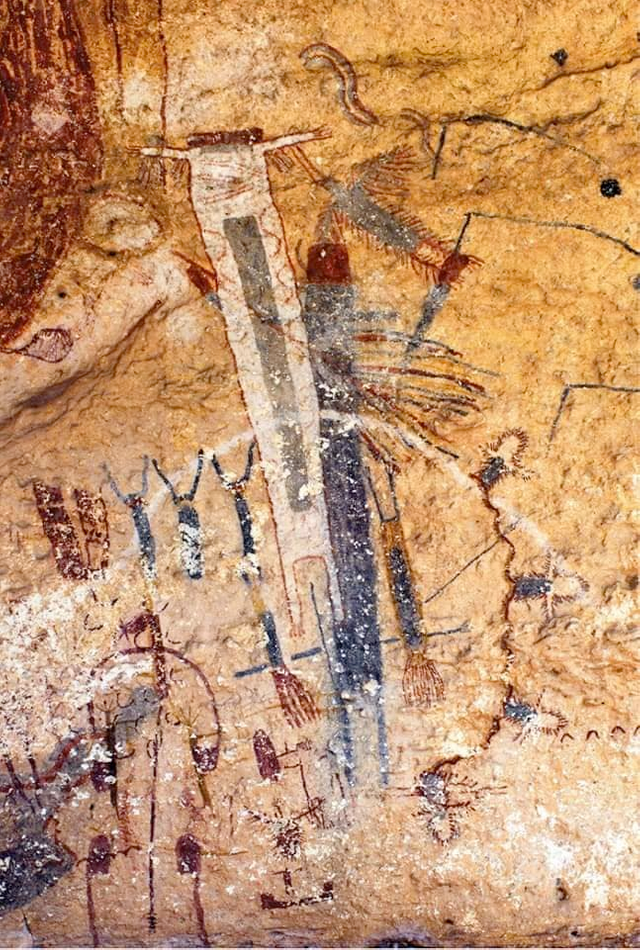If these walls could talk
Pictographs of the Pecos River have existed for millennia in a harsh desert and remained largely silent. Now that an archaeologist has looked at them, they can start talking again.
A white shaman mural is painted on the east wall of a shelter in the southwest, facing west. The placement of the figures in the mural suggests alignment with the sun and shadows.

September 12, 2012 was a long day but a good day. For Carolyn Boyd, it started with a 30-minute drive from her home in Comstock to the 265-acre preserve, where she met up with fellow archaeologists Mark Willis and Amanda Castaneda and pulled off the road. From there it's a half-hour walk past a cactus-streaked rock. The ladder they carried was made for awkward climbing, but with the cool fall it helped to climb the mountain early in the morning. By 8:30 a.m. they had descended from the scrub plateau to a shallow mouth-shaped area near a rugged ridge above the Pecos River. Just downstream, occasional cars and semis drive over the 1,310-foot bridge as US Highway 90 crosses the river about 300 feet below. A little more than a mile below, the Pecos flowed silently to the Rio Grande.
A site of elaborate prehistoric painted rock art known as the White Shaman Murals after its spectrocentric image. Boyd has visited the shelter hundreds of times, but this was the first time she was armed with a $500 Dyno-Lite digital microscope.
The white shaman mural is painted in four colors: red, black, yellow and white. They often overlap or intertwine. Boyd wanted to know in what order the paint was applied. Dyno-light, widely used in medical and industrial applications, was Willis's idea. Using the capsule the size of a handheld microphone, Boyd can examine the margins between pigments at a microscopic level, while simultaneously taking high-resolution photographs for reexamination in the lab.
As Boyd methodically moved across the wall, Willis — viewing images via USB cable on a laptop connected to the Dyno-Lite — shouted what the screen was showing him: “Red rather than black; Black rather than red; Yellow rather than red; Black rather than yellow; White rather than yellow. "
Boyd realized she was hearing a pattern.
“It was clear as a bell,” she recalls. “Red was over black. We found that the black color was the bottom layer everywhere in the whole mural. "
Boyd trained Dino-Lite on the image of the deer with red ants emblazoned with black dots. It is certain that the black dots were originally applied to the wall. Red ants were painted around the dots. “It made absolutely no sense to me as an artist,” says Boyd. “I paint the red body of the deer and paint the black dots. So what else in the world are they doing? … That said, everything made sense. Not just the symbols on the wall, not just the relationship of one symbol to another, not just the color of the symbol – even the order of the paint carries meaning. "
Archaeologists recorded 656 microscopic images and another 1,635 macroscopic images at 42 locations on the White Shaman murals that day. The images are then examined in the lab, subject to double and sometimes triple blind confirmation on large bright screens in the dust and glare of the rock shelter. But Boyd already had a sense of what she'd found.
The Pecos River, thought to have painted a white shaman mural 2,000 years ago, looks a lot like the Pecos River today.
The first time Boyd saw White Shaman, she saw it through the eyes of an artist. Boyd was 30 years old at the time, a successful fine art artist with a gallery in North Houston, and a project to draw artists — musicians, fabricators, potters — at work. “I felt that there was something powerful that an artist could communicate through this act of creation,” she says.
The project focused on the oldest art in North America. A friend told her she should see the rock art in the Pecos, and they headed west, lucked out with a park ranger who helped them access the White Shaman site, and came face-to-face with a voice from the past.
“They had a richer language than ours in describing the stars and the surrounding landscape. … the only brain that put a man on the moon. They had the same cognitive ability as you and me. "
“I immediately recognized how intricate these murals were,” says Boyd. “I was working as a muralist. So I understood what it would take to paint something of that size. It is very interesting. Especially given the circumstances. The floors of these tents are not level. Imagine the challenge of manufacturing scaffolding in such an environment, which would require planning. I was in awe of those who produced them. I wanted to know more. "
Boyd did not know that the White Shaman murals and Pecos River rock art were generally incomprehensible at the archaeological convention—a haphazard collection of images that had been circulating for hundreds or thousands of years, perhaps from nature.

#krsuccess #crazy #war #writes #food #world #animals
Upvoted! Thank you for supporting witness @jswit.
Warning,
This user was downvoted or is blacklisted likely due to farming, phishing, spamming, ID theft, plagiarism, or any other cybercrime operations. Please do your due diligence before interacting with it.
If anyone believes that this is a false flag or a mistake, consider reaching the watchers on Discord.
Thank you,